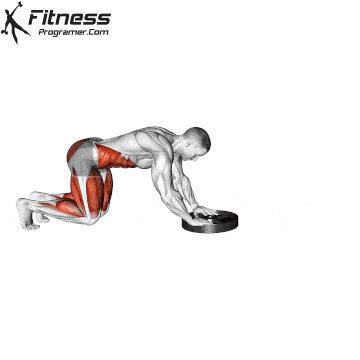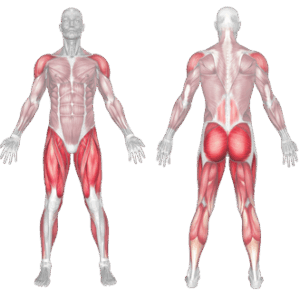Overview
The Plate Push is a high-intensity, full-body exercise that mimics the sled push but uses a weight plate on a smooth surface instead of a sled. This movement helps increase explosive hip extension, strength, speed, conditioning, and functional strength. It’s commonly used in sports performance, CrossFit, and metabolic training to improve leg drive, power output, and cardiovascular endurance.
How to Perform the Plate Push (Step-by-Step Guide)

Place a weight plate flat on a smooth floor (turf, rubber, wood, or tile).
Get into a low athletic stance: hips back, chest down, hands on the edge of the plate, arms extended.
Engage your core, and drive through the balls of your feet to push the plate forward.
Keep your back flat, head in line with your spine, and avoid rounding your shoulders.
Continue pushing for distance or time, using short, powerful steps.
Tips for Proper Form
Keep hips low to engage your glutes and avoid excessive stress on the spine.
Drive from the legs, not the arms—your lower body should do most of the work.
Maintain core tension to stabilize your spine throughout the push.
Use explosive but controlled steps to maintain traction and power.
Look slightly forward, not straight down, to keep a neutral neck position.
Common Mistakes
Standing too upright, which reduces power and efficiency.
Rounding the back, increasing injury risk.
Using only your arms, instead of legs and core to generate force.
Letting heels lift excessively, which decreases drive and stability.
Poor surface choice, creating too much friction or uncontrolled sliding.
Benefits of the Plate Push
Develops Explosive Leg Drive: Trains the quads, glutes, and calves for forceful, forward propulsion.
Improves Conditioning: Elevates heart rate rapidly, making it a great tool for metabolic training and fat loss.
Strengthens Core and Posture: Requires trunk stability to keep the spine aligned during movement.
Enhances Sports Performance: Mimics sprint mechanics and acceleration, beneficial for field athletes.
Low-Impact Alternative to Sprinting: Allows for power training without the pounding forces of running or jumping.
Minimal Equipment Needed: No sled required—just a plate and a smooth surface.
Great for All Levels: Easily scalable by adjusting plate weight or distance.
How to Incorporate Into Your Routine
- For Beginners: Use a lighter plate for 2–3 sets of 10–15 meters focusing on form.
- For Strength and Power: Push a heavier plate for 4–6 rounds of 5–10 meters with full recovery.
- For Crossfit: Pair with lower-body exercises (e.g., squats, lunges) in a superset, emom or amrap format.
- For Functional Training: Include as a finisher in athletic conditioning circuits.
- For Circuit Training: Push for 20–30 seconds as a high-intensity station.
- For General Fitness: Use in HIIT workouts or metabolic finishers for fat loss and endurance.
- For Sport-Specific Prep: Combine with sled sprints, agility drills, or hill work to enhance acceleration.
Plate Push Muscles Worked

Frequently Asked Questions
What surfaces work best for plate pushes?
Turf, polished concrete, smooth rubber flooring, or hardwood. Avoid rough surfaces to prevent damage or stalling.
How heavy should the plate be?
Start light to learn the motion. Progressively load based on your goal—speed vs resistance.
Can I push with two hands or alternate hands?
You can push with both hands or even try one-arm pushes for variety and added core challenge.
Is this safe for knees or lower back?
Yes, if form is strict. Keep hips low and core engaged to protect joints and avoid strain.
How does it compare to sled pushing?
Similar benefits, but requires more friction control and body tension to move the load smoothly.
